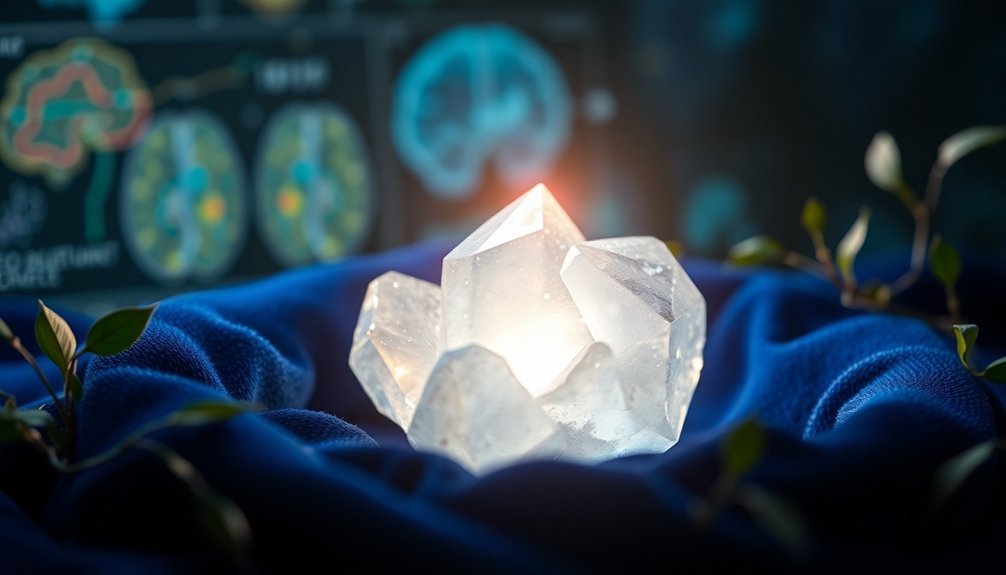To truly illuminate your pineal gland, mastering melatonin production is key. This small gland regulates your sleep-wake cycle by producing melatonin, primarily when it's dark. Light exposure, especially blue light from screens, can interfere with this process, delaying your sleep onset. By creating a low-light environment in the evening, you can boost melatonin levels, helping you fall asleep faster and improve sleep quality. Remember, a balanced circadian rhythm is essential for overall health. By exploring various strategies, you can enhance your melatonin production and optimize your well-being, leading to deeper insights into your body's natural rhythms.
Anatomy of the Pineal Gland

The pineal gland, a small but vital structure nestled in the epithalamus, plays an important role in your body's circadian rhythms. It's located in the midline of your brain, tucked between the two superior colliculi and behind the third ventricle. This tiny gland develops as an outward projection from the posterior wall of the third ventricle and is held in place by the pineal stalk, which splits into inferior and superior laminae.
You'll find that the pineal gland is primarily made up of pinealocytes, specialized neurons designed to secrete melatonin. These cells feature 4–6 processes extending from their cell bodies, giving them a unique shape. Supporting these are astrocyte-like neuroglial cells, along with interstitial cells characterized by darker cytoplasm, adding to the gland's complexity. Additionally, the pineal gland is classified as a secretory circumventricular organ, enabling it to modulate hormone production with direct blood access.
In terms of blood supply, the pineal gland receives a rich flow from the posterior choroidal arteries, highlighting its significance. This blood supply is second only to the kidneys when considering blood flow relative to mass.
Furthermore, the gland is carefully isolated from your body's general circulation by the blood–brain barrier. Understanding the anatomy of your pineal gland helps you appreciate its vital functions.
Melatonin Overview
Melatonin, often dubbed the "sleep hormone," is essential for regulating your body's sleep-wake cycle and overall circadian rhythms. This vital hormone is synthesized in the pineal gland, starting with the amino acid L-tryptophan, which transforms into serotonin through various enzymatic reactions. Serotonin is then converted into N-acetylserotonin, followed by its final transformation into melatonin via methylation. This entire process involves multiple cofactors and enzymes, illustrating the complexity of melatonin production.
Your body's internal clock, the suprachiasmatic nucleus (SCN) located in the hypothalamus, regulates melatonin secretion. Light exposure to your retina inhibits production, while darkness signals your pineal gland to release it. Interestingly, melatonin is often referred to as the "hormone of darkness(light exposure)" due to its secretion at night. You'll notice that melatonin levels peak at night and drop during the day, aligning with your natural circadian rhythm. Seasonal changes also impact these levels, with melatonin often higher during the autumn and winter months.
Role of Darkness in Production

Without darkness, melatonin production wouldn't happen efficiently, as the pineal gland relies on this absence of light to trigger its secretion.
When it's dark, the pineal gland receives signals from your retinas indicating that it's time to produce melatonin. This hormone peaks at night and plummets during daylight hours.
However, exposure to even low levels of light—especially blue light from screens—can suppress melatonin release. Plasma melatonin levels are low during the day and rise before sleep, reinforcing the importance of a dark environment.
If you expose yourself to bright light in the evening, you might notice delayed melatonin production, making it harder to fall asleep.
To promote healthy melatonin levels, creating a dark sleep environment is key. Consider investing in blackout curtains or shades to block out any disruptive light.
Also, steer clear of screens before bedtime; doing so helps guarantee your body can naturally raise melatonin as darkness falls.
Circadian Rhythms Explained
Circadian rhythms play a fundamental role in regulating your body's natural processes, including sleep. These natural oscillations repeat roughly every 24 hours and can be found in a broad range of life forms, from animals to plants and even fungi.
The central clock governing these rhythms is located in the suprachiasmatic nucleus (SCN) of your hypothalamus. It works by utilizing clock genes such as *Clock*, *Bmal*, *Per*, and *Cry* through intricate feedback loops.
Your body's daily sleep-wake cycle is a key aspect of these rhythms, influenced considerably by melatonin production. As evening approaches, your body temperature cools and melatonin levels rise, signaling it's time for sleep.
Environmental cues, known as zeitgebers, like light and temperature, help synchronize your circadian rhythms with the 24-hour solar day.
Furthermore, even in constant conditions, these rhythms persist. This adaptability offers a distinct advantage, enabling your body to optimize physiological functions such as hormone secretion and metabolism.
Impact of Light Exposure

Light exposure plays a critical role in regulating your melatonin production.
When daylight hits your eyes, it can inhibit melatonin release, making it harder for you to wind down at night.
Particularly, blue light from screens can disrupt this process, leaving you feeling alert when you should be preparing for sleep.
Daylight Inhibition Mechanism
The impact of light exposure on melatonin production is profound, directly influencing your body's natural rhythms. When you're exposed to light, especially in the evening, it can greatly delay melatonin secretion.
Even at low illumination levels around 250 lux, melatonin release can be pushed back by at least one hour. Higher light intensities, like 500, 1000, or even 2500 lux, further inhibit melatonin secretion, but not completely.
Blue light is particularly harmful in the evening; it considerably lowers melatonin levels, dropping from 12.0 pg/mL to 8.8 pg/mL. Short wavelengths are the most effective at suppressing melatonin, while even dim light (5-40 lux) can reduce melatonin production by up to 99%.
The timing of your light exposure plays a crucial role too. Light in the early biological night can delay melatonin, while exposure in the late night can advance secretion.
Be mindful that quick changes to bright light in the morning can instantly suppress melatonin levels. Understanding this daylight inhibition mechanism is essential for managing your sleep-wake cycles effectively.
Nighttime Melatonin Release
When you're exposed to evening light, even at low levels, your body's melatonin production can be greatly suppressed. This suppression delays the natural increase of melatonin levels, affecting your shift into biological nighttime.
Just a two-hour exposure to light in the evening can greatly hinder melatonin production, particularly with shorter wavelengths. When light exposure occurs, the suppression can linger even after the light is turned off, delaying melatonin levels from rebounding for up to 50 minutes.
You may not realize that dim light exposure, as low as 5-40 lux, can reduce melatonin levels by an average of 78% in preschoolers. Your sensitivity to light also plays a role.
Younger children are especially vulnerable, with their melatonin suppressed even by minimal light exposure before bedtime. Bright light in the afternoon to early evening delays melatonin production, interfering with your circadian rhythms.
To protect your melatonin production, consider dimming lights and avoiding screens in the evening. The more mindful you're about light exposure before bed, the better your body's shift into sleep and overall melatonin release will be.
Blue Light Effects
Blue light exposure from screens and artificial lighting can greatly disrupt your melatonin production and circadian rhythms. This light reaches your retina and activates special cells that send confusing signals to your brain's suprachiasmatic nucleus (SCN), signaling it's daytime—even when it's night. As a result, your pineal gland struggles to produce melatonin effectively.
Here are three key effects of blue light on your body:
- Melatonin Suppression: Blue light suppresses melatonin secretion more powerfully than other light types, disrupting your sleep even with low exposure.
- Circadian Rhythm Misalignment: Chronic exposure to blue light can lead to chronic insomnia and shift your internal clock out of sync with the natural day-night cycle.
- Long-lasting Impact: The suppression of melatonin can last twice as long as green light exposure, greatly shifting your circadian rhythms.
To mitigate these effects, try avoiding bright screens for two to three hours before bed, utilizing blue-blocking glasses, or using apps that filter harmful wavelengths.
Protecting your melatonin production is essential for a healthy sleep cycle and overall well-being.
Benefits of Melatonin
Melatonin plays an essential role in enhancing your sleep quality and stabilizing your circadian rhythm.
By improving both the duration and quality of your rest, it helps you feel more refreshed each day.
Additionally, its neuroprotective properties can support your brain health as you age.
Sleep Quality Improvement
Over the years, melatonin has emerged as a popular option for improving sleep quality. Many find its benefits hard to ignore, especially when it comes to:
- Reduction in Sleep-Onset Latency: Melatonin helps you fall asleep faster, cutting down the time it takes to doze off by an average of 7.06 minutes compared to a placebo. For those struggling with delayed sleep, this effect can be significant.
- Increase in Total Sleep Time: You can also enjoy slightly extended slumber, with melatonin increasing total sleep duration by an average of 8.25 minutes. While it may not seem like much, every minute counts when you're aiming for restorative rest.
- Improvement in Overall Sleep Quality: Research shows melatonin enhances your overall sleep quality, making your nights more rejuvenating. This can be especially beneficial if you're dealing with conditions like respiratory issues or metabolic disorders.
Circadian Rhythm Stabilization
Quality sleep is closely linked to the stability of your circadian rhythm, which governs the body's internal clock. By regulating melatonin production, this rhythm helps maintain peak health and well-being. When melatonin is secreted in response to darkness, it strengthens your sleep patterns.
The suprachiasmatic nucleus (SCN) plays a key role in synchronizing melatonin production to the 24-hour light-dark cycle, emphasizing the importance of daily light exposure.
If your light exposure is inconsistent, you can experience disruptions in your circadian rhythm, which may lead to various health issues. Stabilizing your rhythm can improve cognitive performance, the regularity of menstrual cycles, and even your immune function.
Additionally, activities like consistent sleep schedules, mindful eating, and regular physical exercise can further enhance your circadian stability.
Neuroprotection and Aging
As you age, protecting your brain becomes increasingly important, and melatonin plays a key role in this process. This powerful hormone not only supports sleep but also enhances neuroprotection against age-related decline.
Here are three crucial benefits of melatonin that you should know:
1. Oxidative Stress Reduction: Melatonin acts as a potent scavenger of harmful reactive oxygen and nitrogen species (ROS/RNS), thereby reducing oxidative brain damage.
Its metabolites further enhance this effect, shielding macromolecules like DNA from free radical aggression.
2. Prevention of Neurodegenerative Diseases**: Melatonin helps slow down brain aging and protects against neurodegenerative diseases such as Alzheimer's** and Parkinson's.
By reducing amyloid-beta-induced toxicity and regulating neuroplasticity, it contributes to better brain health.
3. Anti-Inflammatory Support: Melatonin decreases inflammation in the brain, which is crucial since neuroinflammation is linked to conditions like Alzheimer's.
By modulating ongoing inflammatory responses, it fosters a healthier environment for your neurons.
Incorporating melatonin into your routine can be a proactive step toward preserving your cognitive health as you age.
Neuroprotective Effects

Throughout modern research, the neuroprotective effects of melatonin have gained significant attention due to their potential in combating neurodegenerative diseases. Melatonin reduces oxidative stress by scavenging reactive oxygen and nitrogen species, which helps protect your neurons. It also lowers cellular calcium excess and prevents mitochondrial apoptosis, reducing the impact of ischemia-reperfusion injury.
By enhancing mRNA transcription for superoxide dismutase and boosting the activity of antioxidant enzymes, melatonin fortifies your cellular defenses against oxidative damage.
When it comes to specific neurodegenerative conditions, melatonin proves beneficial. In Alzheimer's models, it inhibits beta-amyloid precursor protein secretion, suppressing amyloid fibril formation. For Parkinson's, it prevents dopamine auto-oxidation, reducing oxidative damage. It further protects against Huntington's by mitigating oxidative stress and improving mitochondrial function.
Additionally, melatonin helps counteract neurodegeneration from glutamate excitotoxicity and offers protective benefits in stroke situations by reducing infarct size and cerebral edema.
These neuroprotective traits make melatonin a promising ally in preserving neurological health as you navigate the challenges of aging.
Reproductive Health and Melatonin
Melatonin plays an essential role in regulating your menstrual cycle and influencing puberty onset.
By affecting hormone release and maintaining balanced levels, it helps guarantee your reproductive processes function smoothly.
Understanding how melatonin interacts with these stages can give you valuable insights into your reproductive health.
Menstrual Cycle Regulation
When it comes to menstrual cycle regulation, understanding the role of melatonin is vital. This hormone, produced by your pineal gland, influences key processes within your reproductive health. Here's how it impacts your cycle:
- Circadian Rhythm: Melatonin production is tied to your body's internal clock and light exposure. A disruption in sleep can lead to hormonal imbalances that affect ovulation and fertility.
- Luteal Phase Dynamics: During the luteal phase, melatonin levels rise, which seems to stimulate progesterone production. This interaction is critical for maintaining a regular menstrual cycle.
- Hormonal Balance: Consistent sleep and regular melatonin exposure help regulate other hormones like luteinizing hormone and follicle-stimulating hormone, supporting ovulation and overall menstrual health.
If your sleep quality is poor or inconsistent, you're likely setting yourself up for cycle irregularities.
For many, taking melatonin supplements might help improve sleep, but it's important to consult with a healthcare professional.
Keep your sleep schedules consistent, and make adjustments that support your body's natural rhythms for the best outcomes in menstrual cycle regulation.
Puberty Onset Influence
Understanding how melatonin affects puberty onset provides valuable insights into reproductive health. Elevated melatonin levels during prepubertal years keep the hypothalamic-pituitary-gonadal (HPG) axis in check, preventing early pubertal development.
As puberty approaches, melatonin levels drop, triggering the release of gonadotropin-releasing hormone (GnRH) and initiating the changes you associate with puberty. This decrease in melatonin, typically around 75%, is essential for the activation of reproductive hormones like luteinizing hormone (LH) and follicle-stimulating hormone (FSH).
In children experiencing constitutional delayed puberty (CDP), high nocturnal melatonin levels inhibit sexual maturation hormones and can lead to delayed physical development. Conversely, low melatonin levels in some may signal precocious puberty.
The relationship between melatonin and puberty stages is notable; as you shift through Tanner stages, nocturnal melatonin levels decline considerably. The timing of these hormonal shifts is also influenced by age and developmental stages.
Understanding melatonin's role not only sheds light on its impact during puberty but also emphasizes the importance of maintaining healthy melatonin production for ideal reproductive health.
Disorders Related to Melatonin Levels

A significant number of individuals experience disorders related to melatonin levels, which can impact both sleep quality and overall health. Low melatonin levels can lead to several troubling symptoms, including insomnia, restlessness, and chronic exhaustion. You might find yourself struggling to fall asleep or feeling persistently tired.
Here are some common disorders associated with low melatonin levels:
- Circadian Rhythm Sleep Disorders: Disrupts your sleep timing, affecting both duration and quality.
- Concentration Problems: You may experience brain fog, making it tough to focus during the day.
- Fatigue: A lack of energy in the morning can leave you feeling unmotivated and hinder your daily performance.
Conversely, high melatonin levels can also cause issues, like excessive daytime drowsiness and headaches, often due to supplements or irregular sleep cycles.
Understanding these disorders can help you identify any signs of melatonin dysregulation in your own life. If you suspect you might be affected, consulting a healthcare professional can provide guidance tailored to your needs.
Pineal Gland Pathophysiology
Pathophysiology of the pineal gland reveals its complex role in regulating various bodily functions, primarily through melatonin production. When the pineal gland is affected by tumors, such as germ cell tumors, you might experience symptoms like headaches, nausea, and Parinaud syndrome, which limits your ability to move your eyes upwards due to compression of the superior colliculi.
These tumors can even lead to hydrocephalus, causing increased cerebrospinal fluid pressure.
Calcification in the pineal gland, occurring in about 40% of Americans by age 17, can impair its ability to synthesize melatonin. While the direct impact on sleep is still debated, severe damage can accelerate puberty and disrupt reproductive development, particularly in children.
Additionally, the gland's anatomical position makes it prone to compression that can block cerebrospinal fluid circulation, leading to symptoms such as nausea, visual changes, and seizures—manifesting as hydrocephalus if untreated.
Ultimately, your pineal gland not only influences melatonin production but also plays a significant role in hormonal regulation and neuroprotection. Understanding these physiological aspects can enhance your awareness of how to keep your pineal gland functioning effectively.
Diagnostic Methods Available

Diagnosing issues related to the pineal gland requires a multifaceted approach that combines advanced imaging techniques, clinical evaluations, and laboratory analyses.
You'll often start with imaging studies like MRI scans, which are the gold standard for diagnosing pineal tumors, offering high-resolution images without radiation exposure. They also help detect conditions like hydrocephalus and reveal the tumor's relationship to surrounding structures.
Consider these key diagnostic methods:
- Neurological Examination: This assesses symptoms related to the tumor, including eye movements, cognitive changes, and sleep disturbances, helping identify neurological deficits.
- Biochemical Markers and CSF Analysis: Blood tests can measure markers like alpha-fetoprotein and beta-human chorionic gonadotropin, which are vital for differentiating tumor types. Analyzing cerebrospinal fluid can enhance this diagnostic precision.
- Biopsy and Histopathological Analysis: Occasionally necessary, a biopsy confirms the diagnosis and guides treatment. Histopathological analysis reveals the tumor type and grade, providing significant information for personalized care and planning.
Through these extensive methods, you'll gain a clearer picture of any potential pineal gland issues, ensuring effective management moving forward.
Therapeutic Options and Approaches
Maneuvering the treatment landscape for pineal region tumors involves a variety of therapeutic options tailored to individual patient needs. Typically, surgery is the first line of treatment, aiming to obtain tissue for analysis while removing as much tumor as possible.
Depending on the tumor's size and location, approaches like the Supracerebellar Infratentorial or Occipital Transtentorial may be employed, with minimally invasive techniques like endoscopic surgery to aid recovery.
When surgery isn't viable, radiation therapy becomes vital. It's particularly effective for radiosensitive tumors, helping prevent recurrence and often used in conjunction with other therapies.
Chemotherapy plays an important role for malignant tumors, especially when surgical efforts fall short. You may encounter drugs like cisplatin and etoposide, tailored to address specific tumor types.
Lastly, don't overlook the potential of clinical trials offering cutting-edge treatments. Investigations into immune checkpoint inhibitors and other targeted therapies aim to enhance outcomes by tailoring approaches based on genetic profiles.
Combination therapy is frequently necessary to tackle complex cases effectively, ensuring a thorough strategy for your treatment.
Frequently Asked Questions
How Does Age Affect Pineal Gland Function?
As you age, your pineal gland's melatonin production declines markedly, disrupting sleep patterns. You may find it harder to fall asleep and experience shorter, disturbed sleep cycles, impacting overall health and well-being.
Can Lifestyle Changes Enhance Melatonin Production?
Yes, lifestyle changes can enhance melatonin production. Get ample daytime light, eat tryptophan-rich foods, practice good sleep hygiene, and minimize evening screen time to support your body's natural rhythms and improve sleep quality.
What Foods Promote Natural Melatonin Synthesis?
To promote natural melatonin synthesis, incorporate pistachios, almonds, tart cherries, and oats into your diet. Adding fatty fish and mushrooms can also help, ensuring you get a well-rounded intake of melatonin-rich foods.
Are There Risks Associated With Melatonin Supplements?
Yes, there are risks associated with melatonin supplements. You might experience headaches, dizziness, or daytime sleepiness. It's crucial to evaluate your medications and health conditions before using melatonin to avoid potential interactions and side effects.
How Does Stress Impact Melatonin Levels?
Stress impacts your melatonin levels by increasing cortisol, which then inhibits melatonin production. This disruption can lead to lower nighttime melatonin, affecting your sleep-wake cycles and overall circadian rhythms, making relaxation essential for better sleep.
In Summary
Mastering your melatonin production can greatly enhance your well-being. By understanding the anatomy and function of your pineal gland, you can harness the power of darkness to regulate your circadian rhythms. Being mindful of your light exposure, you can fine-tune your sleep patterns and improve your overall health. If you're facing melatonin-related disorders, remember that diagnostic methods and therapeutic options are available. Embrace these strategies to illuminate your pineal gland and promote a restful, rejuvenating sleep.





Leave a Reply